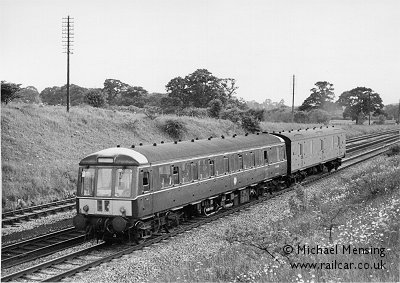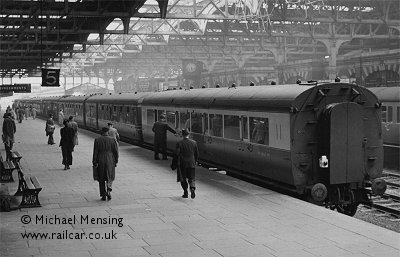DMU Tail Loads
Particularly in the early days of their introduction, a DMU hauling a tail load was not an unusual sight.
One of the main reasons that DMUs were given vacuum brakes, when air brakes would have been easier and more practicable, was to allow this operation as hauled stock was only vacuum braked at the time.
Recollections
Chris Thompson remembers catching the train from Oakhampton to Exeter Saint Davids, 1969-71. The formation was a 3-car unit plus a bubble car (Class 121 or 122) pulling ex-SR utility van or CCT.

GRCW Bubble 55010 has a GUV in tow, leaving Hatton Station on the 6.35pm Gloucester (C) - Leamington Spa. 13th June 1966. Michael Mensing.
Stuart Rutherford has sent in details of the 17.30SX (or thereabouts) Middlesbrough – Saltburn service in 1976/77. It was an extra train in the then half-hourly Darlington-Saltburn service; and from what he recalls, was a Met-Cam power twin set and took a van of some sort carrying mail which was loaded at Middlesbrough station platform. At this distance in time, he can’t recall exactly what the van was, but it may have been a standard BR bogie GUV.
Stuart also offered some notes from BR Sectional Appendices from the late 1960’s/mid 70’s which contain some information on tail loads:
- Eastern Region (Southern Area) Jan 1969 has a section (2/3rd page) on “Working of 4-Wheeled Diesel Rail Buses”, in East Anglia, and about 1 1/3rd pages on Tail Traffic, with weight limits and routes, including a note that the 4.24pm (Sundays) Cambridge to Bletchley train may convey a van of milk churns from Stowmarket to Bedford (St Johns).
- Eastern Region (Northern Area) Jan 1969 has 4 pages with details of route/composition of train/maximum tail load. In this one there are details about the on he remembers above; in 1969, 2D63 17:21 Middlesborough-Saltburn was booked to comprise a twin power set (2 cars 600BHP) and could convey a 100 tons gross tail load. Also 2D50, 04:30 Darlington-Saltburn could convey an 80 ton tail load so long as it was 2 cars (600BHP), 3 cars (600BHP) or 4 cars (900BHP). In 1972 this train (by then 2N50), was booked to stand at Middlesbrough from 05:00-05:20, presumably to unload mail (plus newspapers??).
- Scottish Region Oct 1977 has a page with train composition/max tail load.

The parcels cars regularly hauled tail loads, the powerful Albion engines on the GRCW units were used to allow this. The image shows one of these, probably M55990, with two vehicles in tow at Cricklewood on 20/12/60. David Lamb.
Paul Fishwick recalls a CCT on the back of an early evening Manchester Picc. - Liverpool Lime St limited stop service (formed typically of 115s) during the late 1970s/early 1980s. He's sure it used to run SX and departed from Widnes around 7-7:30.
From Eric Stuart: "I remember an up evening train from Barnstaple to Exeter (2x3 dmu) hauling a GUV. I think the tail-load worked down on the first train, but I could only hear it, not see it, as it was quite early!" (Rory Wilson adds to this: "the first Down DMU, 04.05 Exeter St David's in the early 1980s if I remember correctly, used to have a GUV containing newspapers off the Paddington newspaper train as a tail load. The GUV started at Exeter: it wasn't detached off the portion of the Paddington that served Exeter; instead the North Devon papers were transferred over"). Eric continues: "I saw a 3-car 101 at Whitby Town, with a fish van in tow. One working I never saw, was the Class 115 on the Chesham branch, which had to run-round the BG at Chesham. Tail-loads of vans of various sorts were very common. Kevin Robertson's book includes a number of pics of this kind of traffic. I find the towing of passenger vehicles of interest and rarely photographed. A pic in Railway Bylines shows a Bubble Car on the Kingsbridge branch towing a Hawksworth BC. Very interesting, as this is the only incident I have ever seen of such. The Inter-city and Cross-Country sets on the Birmingham - ;South Wales service used to tow a passenger coach at peak times. The later GWR cars hauled both passenger and freight vehicles; occasionally both. The Lambourn branch is probably the most frequent producer of such workings. Both GW cars and Cl 119s ran with loco-hauled stock wired-through and incorporated within in the train. There are a few pics of these workings around (the Hawksworth Coaches)."

Birmingham Snow Hill in June 1958, and W5865W is at the rear of a 6-car Swindon Cross-Country set. Michael Mensing.
Tom Clift recalls: "The Central Wales Line had regular tail traffic on the first southbound & last northbound services for several years post dieselisation in 1964. This was for mail traffic & a throw back to pre 1964 when the two services concerned started from/terminated at York. The hauled vehicle was any variety of 8 wheel BG/GUV/CCT. Because of the messy detachment/attachment arrangements at Llanelli, towards the end a Class 122 Drive End Trailer was used instead (W56293 springs to mind, & also 121 x W56285?) to make life easier & let the vehicle run to/from Swansea with the 'hauling unit.' The decline of mail carried put an end to this arrangement.
Also, when there were peak traffic requirements (i.e. Summer Saturdays, The
Royal Welsh Agricultural Show or Shrewsbury Flower Show) it was not uncommon
for an SK to be attached at Llanelli on the busiest morning departure going
north to provide more capacity. The formation would be turned on the triangle
at Salop for the return working. This was a pretty hopeless for the Guard
trying to issue tickets with no corridor connection, & also the adverse
effect on power:weight ratio affected time keeping on this hilly route.
At this time the line was worked by a select fleet of headlight fitted
Class 120 Swindon Cross Country units (June 1964 to May 1982) in Power Twin
formation."


